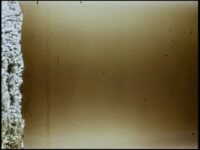It all began with visual art. David Lynch went to art school and he worked with whatever material that seemed to be of interest in the moment; assemblages, photography, painting, collages and sculptures. His works are the results of chaotic creative processing of mixed media. Lynch included everyday objects into his art. Stuff that we otherwise know as ”trash” were put in another context as a result of a playful mind in the here and now.
In Lynch’s earlier works as an artist, clothing, food (and the decomposition that follows), dead bugs and building materials are all incorporated to cooperate with the more conventional artist’s materials.
Lynch’s artworks still vary material-wise as well as in size – he creates monumental pieces as well as tiny little ones. The tools he use in the artistic process shift from bare hands and fine brushes to drills and other mechanical devices. In the 2016 biographical movie David Lynch – The Art Life (directed by Jon Nguyen), David Lynch offers us an insight into his creative processes.
(Take my word for it, if you didn’t know it already – different artists have immensely different ways of working. just like anyone would really because we’re all different. My personal experiences in working at art museums for the last 10 years have enabled me to see this in others first hand, and my own artistic work process differs a lot from some of my close friends that are artists too. I believe looking at the process behind the artistic “product” of the artwork is just as interesting, if not even more so, than beholding the final result. The journey there is when we learn and develop.)
In David Lynch – The Art Life, Lynch tells us stories from life from the age of being a child to adulthood, and between. In a personal and reflecting way we learn about hard times, good times and times of change and self-realization.
The film is a pleasant watch and a must-see for any fan of David Lynch. Especially if you’re interested in witnessing the playful and experimental creative process that seems to be ever so present whenever Lynch is working, be it with his visual art or with his big and perhaps better-known movie classics. If you don’t know too much about his visual art outside of his big movies, The Art Life is a good way to start your exploration of the parallel, but well connected, universe of David Lynch.
Many of us fans know that David Lynch started off as a painter way before he got into film making, and many will also recognize this Lynch quote that describes how and why he eventually started making movies and film:
”I wanted my paintings to move.”
I rewatched The Art Life the other day, just after part 8 of Twin Peaks: The Return aired. That’s when I found something curious that I want to share with you.
In the film, we follow David Lynch’s artistic journey. Right around the time before his daughter Jennifer Lynch was born (in the spring of 1968) Lynch appearently “wanted his paintings to move”, and so he started working on a short movie. It was to be a partly animated piece taking up part of the screen, and with acting by Mary Fisk playing parallell in the rest of it.
(Side note trivia: Lynch and Fisk would eventually be married between 1977-1987. Their son, Austin Jack Lynch, can be seen in Twin Peaks playing the role of The Grandson, the little boy that magically makes the Garmonbozia disappear from Mrs. Tremond’s Meals on Wheels plate.)
David Lynch describes his work with this early short film in The Art Life in these words:
”It was gonna be Mary Fisk dancing on one third of the screen, and on the other two thirds an animated thing. So I animated that thing for two months, and I had a hundred feet of film in the camera. And I didn’t know technically what I was doing really. But I took the hundred foot roll out of the camera, took it to the lab and a couple of days later I got it back. And I was standing in the doorway ’cause I would open the door so I would get sunlight. And I just wanted to check the first part, make sure that everything was OK.”
But the film wasn’t OK. The entire roll showed nothing of that what Lynch had been working on for months. Lynch continues:
”And it dawns on me that this entire roll, negative, is a blur.”
Stills from the blurred film roll.
Whether Lynch’s (at this time) inexperience with the technical part of film making was the factor behind the roll of film seemingly being overexposed to light and therefore destroyed, the story doesn’t say. And maybe it didn’t matter to Lynch what the cause was.
Anyone would feel crushed and very disappointed about something like this, yet in The Art Life, Lynch comments:
”In a strange way I wasn’t that upset, ’cause I must have been getting an idea for something more.”
That’s where this story could have ended. But after Part 8 of the new Twin Peaks material, I don’t think it did.
Because in part 8, inside of the huge blast of the atomic bomb, I find something that I recognize:
Stills from within the atomic bomb explosion, Twin Peaks The Return, part 8, 2017.
I watched the different footage – the blurred roll of film and the atomic blast of Twin Peaks – side by side several times. I think they are the same. Something orangeish, pulsating, speckled with occasional black scratches or spots. I wouldn’t mind too much about the fact that the footage included for seconds in the Twin Peaks version have a slightly deeper, darker color. Those are things that can be easily digitally altered. But just in case the pictures above don’t get the similarities across I made a short moving comparison as well:
[youtube https://www.youtube.com/watch?v=QmqKEmr_Czw?rel=0&controls=0&showinfo=0&w=640&h=360]
Maybe that blurred ”failure” of a film back in the late 1960s actually did become ”something more”, after all. If it did, I believe it fits well with David Lynch’s creative process while working artistically. The thrown away, the failed and the already existing things that still linger in a locker somewhere, or in the back of your mind. Those things might just be the hidden gold that you’re looking for, waiting patiently to be seen.
Meanwhile…






It’s just there, it pops up! I’m a highly visual person, but I can’t do maths. I’m glad you enjoyed!
How do you notice all these little things…fantastic!